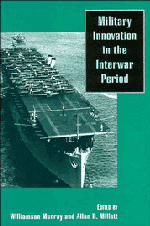Book contents
- Frontmatter
- Contents
- Acknowledgments
- Introduction
- 1 Armored warfare: The British, French, and German experiences
- 2 Assault from the sea: The development of amphibious warfare between the wars – the American, British, and Japanese experiences
- 3 Strategic bombing: The British, American, and German experiences
- 4 Close air support: The German, British, and American experiences, 1918–1941
- 5 Adopting the aircraft carrier: The British, American, and Japanese case studies
- 6 Innovation ignored: The submarine problem – Germany, Britain, and the United States, 1919–1939
- 7 From radio to radar: Interwar military adaptation to technological change in Germany, the United Kingdom, and the United States
- 8 Innovation: Past and future
- 9 Patterns of military innovation in the interwar period
- 10 Military innovation in peacetime
- Index
4 - Close air support: The German, British, and American experiences, 1918–1941
Published online by Cambridge University Press: 05 August 2012
- Frontmatter
- Contents
- Acknowledgments
- Introduction
- 1 Armored warfare: The British, French, and German experiences
- 2 Assault from the sea: The development of amphibious warfare between the wars – the American, British, and Japanese experiences
- 3 Strategic bombing: The British, American, and German experiences
- 4 Close air support: The German, British, and American experiences, 1918–1941
- 5 Adopting the aircraft carrier: The British, American, and Japanese case studies
- 6 Innovation ignored: The submarine problem – Germany, Britain, and the United States, 1919–1939
- 7 From radio to radar: Interwar military adaptation to technological change in Germany, the United Kingdom, and the United States
- 8 Innovation: Past and future
- 9 Patterns of military innovation in the interwar period
- 10 Military innovation in peacetime
- Index
Summary
The history of air power in Germany, Britain, and the United States during the interwar period provides excellent examples of successful military innovation. To some degree, each air force combined the lessons learned in World War I, postwar theoretical development, and increasingly advanced aviation technology into viable doctrines, weapons systems, and combat formations. The creation of a long-range heavy day bombardment force by the United States Army Air Corps and the establishment of an integrated air defense system in Britain are only the most well known of these developments. Although in most cases capability fell far short of the “ideal” suggested by army air corps, Luftwaffe, or RAF doctrine, the leadership of each service had thought through the problems of, and implemented the means of, executing the missions of conventional bombardment, pursuit, and observation aviation.
In contrast, the ability of the major air powers to carry out the task of close air support remained minimal until the final two years of World War II, with the qualified exception of Germany. The air forces of the interwar era even experienced difficulty creating an accepted vocabulary for this form of air attack. “Close air support” (CAS) in its modern usage refers to “air action against hostile targets which are in close proximity to friendly forces and which require detailed integration of each air mission with the fire and movement of these forces” in order to reduce the danger from friendly fire.
- Type
- Chapter
- Information
- Military Innovation in the Interwar Period , pp. 144 - 190Publisher: Cambridge University PressPrint publication year: 1996
- 6
- Cited by



